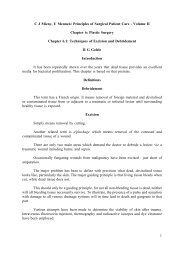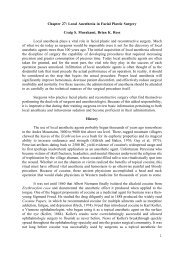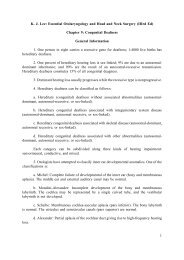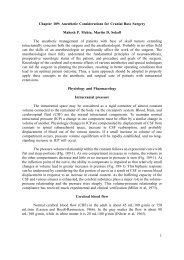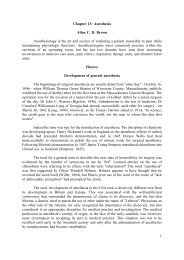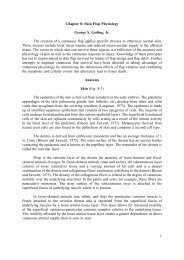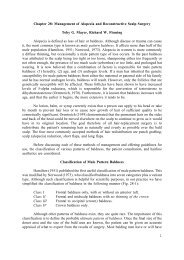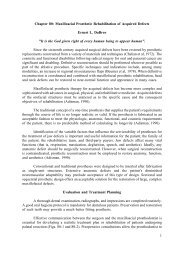1 Chapter 99: Congenital Disorders of the Larynx ... - Famona Site
1 Chapter 99: Congenital Disorders of the Larynx ... - Famona Site
1 Chapter 99: Congenital Disorders of the Larynx ... - Famona Site
You also want an ePaper? Increase the reach of your titles
YUMPU automatically turns print PDFs into web optimized ePapers that Google loves.
<strong>Congenital</strong> interarytenoid web is a rare laryngeal anomaly whose distinctive feature<br />
is a band <strong>of</strong> tissue joining <strong>the</strong> medial surfaces <strong>of</strong> <strong>the</strong> arytenoids and restricting abduction <strong>of</strong><br />
<strong>the</strong> vocal cords (Fig. <strong>99</strong>-17). In addition to <strong>the</strong> interarytenoid web, which is present to some<br />
degree in all patients, associated anomalous features may include subglottic stenosis, enlarged<br />
bulky arytenoids, and difficulty exposing <strong>the</strong> larynx and maintaining <strong>the</strong> airway during<br />
anes<strong>the</strong>sia and endoscopy. Inspiratory stridor is <strong>the</strong> cardinal feature; <strong>the</strong> obstruction may be<br />
severe at birth or may worsen over weeks or months. The stridor is episodic and sometimes<br />
associated with obstructive cyanotic attacks. Diagnosis depends on direct laryngoscopy with<br />
particular attention to <strong>the</strong> posterior larynx without an endotracheal anes<strong>the</strong>sia tube in place<br />
and preferably utilizing a technique <strong>of</strong> insufflation anes<strong>the</strong>sia with spontaneous ventilation.<br />
Direct inspection <strong>of</strong> <strong>the</strong> larynx is difficult to some degree in every case and special-purpose<br />
hand-held laryngoscopes such as <strong>the</strong> Holinger pediatric anterior commissure laryngoscope or<br />
<strong>the</strong> Tucker-Benjamin infant laryngoscope and subglottiscope are helpful. They are used with<br />
rigid telescopes both straight ahead and angled so that <strong>the</strong> posterior commissure and<br />
arytenoids are deliberately separated and palpated to determine <strong>the</strong> consistency and depth <strong>of</strong><br />
<strong>the</strong> web. The arytenoids are <strong>of</strong>ten large and bulky, and <strong>of</strong>ten a congenital subglottic stenosis<br />
is present. It seems likely that some cases have been misdiagnosed as bilateral vocal cord<br />
paralysis and o<strong>the</strong>rs as cricoarytenoid joint fixation or posterior glottic stenosis. The<br />
association with o<strong>the</strong>r congenital anomalies, especially those <strong>of</strong> <strong>the</strong> respiratory tract, is high.<br />
Management<br />
Many forms <strong>of</strong> treatment for congenital laryngeal webs have been advocated, including<br />
dilation, which may be done deliberately (knowing that a web is present) or inadvertently<br />
(while passing an endotracheal tube or a bronchoscope); simple enoscopic microsurgical<br />
division with scissors; endoscopic division with an attempt to prevent recurrence by using<br />
sutures through <strong>the</strong> free cut edge <strong>of</strong> <strong>the</strong> web or <strong>the</strong> repeated use <strong>of</strong> dilators; endoscopic<br />
insertion <strong>of</strong> a keel; laser treatment; or laryng<strong>of</strong>issure to allow removal <strong>of</strong> redundant s<strong>of</strong>t<br />
tissues in <strong>the</strong> subglottic area with or without <strong>the</strong> use <strong>of</strong> a keel.<br />
In general, <strong>the</strong> simpler <strong>the</strong> web and <strong>the</strong> simpler <strong>the</strong> treatment required, <strong>the</strong> better <strong>the</strong><br />
result. Thin glottic webs alone respond well to simple incision or rupture. For <strong>the</strong> remainder,<br />
obtaining a satisfactory result as judged by improvement <strong>of</strong> <strong>the</strong> voice is difficult, as is<br />
improving <strong>the</strong> airway to achieve decannulation when a tracheotomy has been performed.<br />
Infants with congenital interarytenoid web alone usually do not require an artificial<br />
airway. Infants with congenital interarytenoid web and associated congenital subglottic<br />
stenosis or o<strong>the</strong>r congenital anomaly (involving dysmorphic facies or midface hypoplasia)<br />
usually need a tracheotomy, but decannulation is possible after 3 to 5 years with a very good<br />
long-term prognosis.<br />
Posterior laryngeal cleft<br />
A posterior cleft <strong>of</strong> <strong>the</strong> larynx is difficult to diagnose and a frequently missed anomaly<br />
(Cohen, 1975). The posterior cleft may be limited to <strong>the</strong> interarytenoid region, or it may<br />
involve <strong>the</strong> cricoid lamina. When <strong>the</strong> cleft is more extensive, <strong>the</strong> term<br />
laryngotracheoesophageal cleft should be used. A classification into four types has recently<br />
been proposed (Fig. <strong>99</strong>-18; Benjamin and Inglis, 1989).<br />
23




